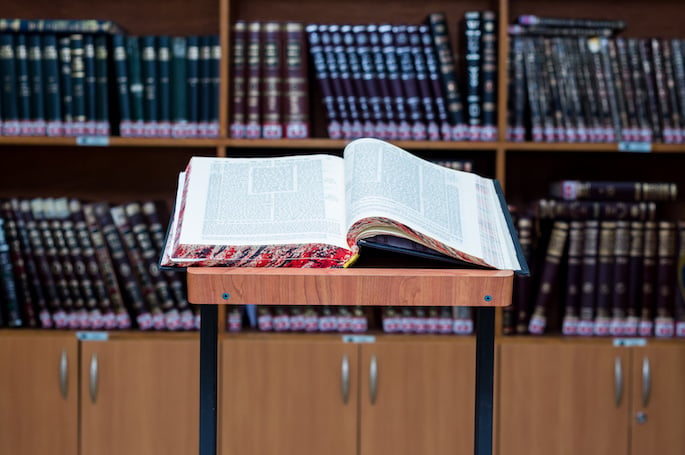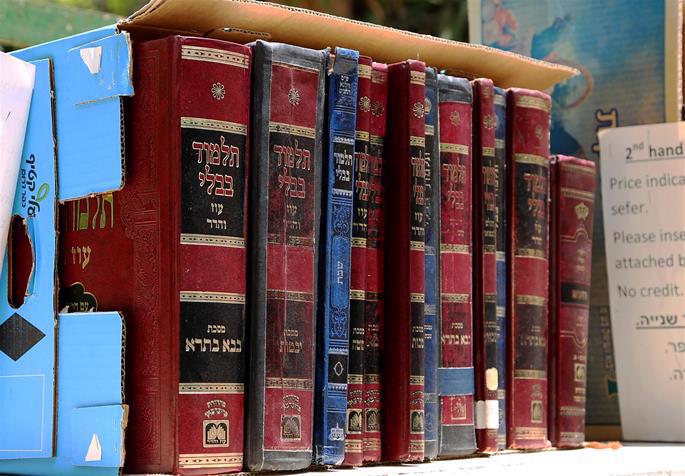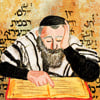Why the Talmud was Needed

As anyone who has learned the Bible can attest, there are certain verses where there is no way of knowing what it refers to by just looking at the verse. Examples include the commandment to circumcise oneself, or to put tefillin on the arm and head, or to take the four species on the Jewish holiday of Sukkot.
There is no way of knowing from the verses alone what exactly are we supposed to cut when we make a circumcision, or how to put on tefillin, or even what it is. The same holds true for almost all other commandments. More details are given in the Written Torah for some commandments than for others, but at the end of the day, there is a glaring lack of detail and information.
This is where the Oral Torah comes in. It is an “owner’s manual” and “companion guide” (so to speak) for the Torah. With it we can understand what the Torah means, and determine the details of the various commandments. Furthermore, we have rules of exegesis so that we can determine the Torah’s view on various issues that are not directly addressed. The Oral Torah comprises traditions and extrapolations based on the inscribed Torah, the Bible.
Just before the giving of the Torah on Mount Sinai, G‑d tells Moses that He will give him “the stone tablets, the Torah and the commandments."1 By adding the word “commandments” in addition to the Torah, G‑d implies that there commandments that are not included in the “Torah.” This, among others, is a clear implication of the existence of the Oral Torah.
The Torah itself commands us to keep the Oral Torah:
You shall do according to the word they tell you, from the place the L‑rd will choose, and you shall observe to do according to all they instruct you. According to the law they instruct you and according to the judgment they say to you, you shall do; you shall not diverge from the word they tell you, either right or left.2
The traditions of the Oral Torah were passed down from generation to generation, from Moses to Joshua, and from there down to the leaders and sages of each generation,3 until eventually, after the destruction of the Second Temple, they were written down in what is known as the Mishnah, Talmud Bavli (Babylonian Talmud) and Talmud Yerushalmi (Jerusalem Talmud).
The above leads us to the obvious question. If the Oral Torah is so essential to understanding the written Torah, why wasn’t the Oral Torah written down to begin with?
The Prohibition of Writing Down the Oral Torah

Before Moses received the second set of tablets, “The L‑rd said to Moses: ‘Write down these words for yourself, since it is through these words [lit., by word of mouth] that I have formed a covenant with you and with Israel.’”4
The Talmud explains that this verse implies that there is a prohibition of saying the written word by heart, and of writing down the Oral Torah:
Rabbi Yehudah bar Nachmani, the public orator of Rabbi Shimon ben Lakish, taught as follows: It is written, “Write down these words for yourself”—implying that the Torah is to be put into writing; and it is also written, “since it is through these words” (lit., “by word of mouth”)—implying that it is not to be written down. What are we to make of this? It means: Regarding the written words, you are not at liberty to say them by heart; and the words transmitted orally, you are not at liberty to recite from a written text.
A tanna of the school of Rabbi Ishmael taught: It is written, “Write down these words”—these you may write (i.e., the Written Torah), but you may not write halachah (i.e., the Oral Torah).5
There are many different reasons given for the prohibition of writing down the Oral Torah. Among them:
● Practically, if the Oral Torah was to be written, including all the laws that govern every possible case that could arise, there would be no end to the amount of books that would need to be written. Therefore, only the parts of the Torah that can be limited—i.e., the twenty-four books of scripture—were to be written down; the rest is supposed to be transmitted orally.6
● Any written text is subject to ambiguities, multiple interpretations, dissensions among the people, and confusion with regards to what actions to take based on the law. Therefore, G‑d also gave a tradition that would be taught orally from teacher to student, so that the teacher could clarify any ambiguities. Had this oral tradition also been put to writing, it would then have required another work of explanation and elucidation to explain that work, ad infinitum. Indeed, this concern was borne out when the Oral Torah was eventually written down.7
● The oral tradition is the explanation of the Written Torah. When it has to be learnt orally, the student will understand it only from a teacher who teaches the material well; had it been written down, one might be tempted to be satisfied with what is written, even without really understanding it.8
● Keeping part of the Torah oral ensures that that the Torah remains the private treasure of the covenantal community. Had the entire Torah been written down, any nation could have copied it and claimed it as their own; now that it was only partially written down, any copying done without access to the Oral Torah would be immediately discernible as foreign to the Torah.9
The Writing of the Talmud

For over a thousand years, from the days of Moses until the days of Rabbi Yehudah the Prince (late 2nd century CE), no one had composed a written text for the purpose of teaching the Oral Law in public. Instead, in each generation, the head of the court or the prophet of that generation would take notes of the teachings which he received from his masters for himself, and teach them orally in public. Similarly, individuals would write notes for themselves of what they had heard regarding the explanation of the Torah, its laws, and the new concepts that were deduced in each generation concerning laws that were not communicated by the oral tradition, but rather derived using one of the thirteen principles of biblical exegesis and accepted by the high court.10 For while there was a prohibition against writing the Oral Torah, it applied only to actually transmitting it through writing; however, one was permitted to write it down for personal use.11
With the rise of the Greek and Roman empires and their persecution of the Jews during the Second Temple era, it became increasingly harder to learn and transmit Torah teachings from teacher to student. Additionally, during this era there were disputes in Jewish law that, due to the increase in decrees against Torah learning, remained unsettled, since doing so would require peace and calm.
By the time the schools of Hillel and Shammai became well established in the century before the destruction of the Temple, disputes on the law had become so widespread that there was fear that it would eventually seem like there were really “two Torahs.” The unsettled conditions prevented the sages of those times from resolving these disputes, or even at least organizing and categorizing them.12
It was not until the days of Rabbi Yehudah the Prince, who enjoyed a strong bond of friendship with the Roman emperor Antoninus, that there was some respite from the Roman persecutions. (See here for the story of how their friendship began.)
Rabbi Yehudah and his colleagues, foreseeing future turmoil and the increasing dispersal of the Jewish people throughout the Diaspora, which would then lead to further uncertainties about the Oral Law, used this period of peace to set about collecting all the teachings, laws and commentaries that had been heard from Moses and which were taught by the courts in each generation concerning the entire Torah. After analyzing these teachings, Rabbi Yehudah composed a single authoritative text that would be available to everyone.
As a basis for his text, Rabbi Yehudah used the teachings of Rabbi Akiva and his disciple Rabbi Meir, due to their great capacity to retain what they learned, and the superb and extremely concise and precise way in which they had arranged their own teachings and what they had heard from previous generations. He also added other teachings, leaving some of their original wording, but also at times changing it.13
Since there were rabbis who might have heard from other sages minority opinions that were not accepted as halachah, Rabbi Yehudah also included these minority opinions in the Mishnah. This way, should a person claim, “I have heard a different tradition from my teachers,” we would be able to point to the Mishnah and say, “Perhaps what you have heard was the opinion of so-and-so.”14
He categorized and divided the laws by subject and into different tractates, and then each tractate was further divided into chapters and laws.15 Each law is called a mishnah, either from the root shanah, meaning “teaching” and “instruction,” or from the root sheni, meaning “second,” as in the second part of the Torah. Thus the entire work in general is called the Mishnah or Mishnayot.16
While all classic sources agree that Rabbi Yehudah redacted the entire Mishnah that we have today,17 there are differences of opinion as to whether he actually wrote it down or continued to teach it orally. Rabbi Sherira Gaon and Rabbi Shlomo Yitzchaki (Rashi) are of the opinion that Rabbi Yehudah merely formulated the entire Mishnah orally, but that it was written down only many years later.18 Maimonides, on the other hand, writes explicitly that Rabbi Yehudah himself actually wrote down the entire Mishnah.19 In an attempt to reconcile the two views, some explain that while Rabbi Yehudah did in fact write a personal copy of the Mishnah, in general it was originally taught orally, and it was only later that the written version was used.20
Not all of the extant material was included in the Mishnah. For had Rabbi Yehudah attempted to collect it all, it would have been too lengthy and would have been forgotten, thus defeating the very purpose of the Mishnah. Instead, Rabbi Yehudah, with the help of his colleague Rabbi Natan, formulated the essential topics and general rules in an abbreviated and precise language. They were divinely aided in composing the Mishnah in such a way that a single word can be the source for a number of fundamental principles of Jewish law as well as homiletics.21
For reasons of brevity, too, the Mishnah does not include many of the laws that were common knowledge, such as the details of tefillin, tzitzit, mezuzah, etc. As an example, the very first mishnah, which deals with the laws of the recital of Shema, does not begin by informing us that it must be recited in the morning and evening, but by asking, “What is the right time for saying the Shema?” taking it for granted that one already knows the actual obligation of the daily recital of the Shema.22
These features of the Mishnah won it general acceptance as the definitive summation of Jewish law; indeed, its compilation (c. 3949/189 CE) marks the end of an era, with the Mishnaic sages being known in Jewish history as the tanna’im (“instructors,” from an Aramaic root cognate with shanah) and the subsequent sages being called amora’im (“explainers”). The Mishnah supplanted all previous collections and formulations of Tannaitic teachings, which then came to be known as baraitot (sing. baraita), meaning “[teachings] outside [the Mishnah].” The most prominent collection of baraitot is that of Rabbi Chiya (a student of Rabbi Yehudah) and Rabbi Oshaya, known as the Tosefta. It follows the order of the Mishnah and supplements it, elaborating somewhat more on the laws.23
In a broader sense, the term baraita includes other collections of material containing teachings by the tanna’im, such as Megillat Taanit, Mechilta, Sifra, Sifri, Seder Olam Rabbah and Zohar.24
Jerusalem and Babylonian Talmuds

The sages of the Talmudic period, known as amora’im, continued to study, expound, clarify and elucidate the Mishnah, as well as developing their own new insights based upon the rules of extrapolation.
Shortly after Rabbi Yehudah’s death, attacks and persecutions against the Jews living in Israel intensified and the migration of Jews to Babylonia increased. This migration included many of the leading sages of the time, including Rabbi Abba Aricha (better known as Rav), one of Rabbi Yehudah’s leading disciples. Other sages and students of Rabbi Yehudah, such as Rabbi Chiya and later Rabbi Yochanan bar Nafcha (who as a young boy attended Rabbi Yehudah’s lectures), remained in Israel. Thus for a while there were major centers of learning, yeshivot, in both Babylonia and Israel, and some amora’im regularly traveled back and forth between them, bringing the teachings of each center of learning to the other center.
Rabbi Yochanan (d. approx. 4050/290 CE) became the leading Talmudic authority in the Land of Israel. He began gathering the teachings and explanations of the post-Mishnaic sages, and this became the basis of what later became known as the Talmud Yerushalmi (Jerusalem Talmud). Subsequent generations of amora’im in Israel continued to add various teachings, especially aggadic (homiletic and non-legal) ones. However, work on the Jerusalem Talmud was halted somewhat abruptly when the Roman ruler Gallus, in the year 4111/351 CE, attacked and devastated the Land of Israel, instituting harsh decrees against the Jews. Most of the remaining sages fled to Babylonia, and the Jerusalem Talmud remained in its rudimentary form.
Meanwhile the centers of learning in Babylonia continued to flourish, and it was not until around the year 4152/392 CE that Rav Ashi, together with his colleague Ravina I, undertook the editing of what was to become the Talmud Bavli (Babylonian Talmud). They gathered the teachings of the earlier sages, organized and clarified their statements about the Mishnah and the discussions of the amora’im on these, and presented these in a logical and comprehensible way.25
Both Talmuds contain many of the same teachings, and each one quotes sages from the other center. However, because the Jerusalem Talmud was never fully redacted while the Babylonian Talmud was, and furthermore because the latter was completed some 150 years later, the Babylonian Talmud is much more widely learned and considered more authoritative. In fact, any unspecified reference to the Talmud almost always refers to the Babylonian recension.
(There are also differences in style—the Jerusalem Talmud is written with less back-and-forth than the Babylonian Talmud—and in language: the amoraic discussions in the Jerusalem Talmud are written in Western Aramaic (Syriac), while in the Babylonian Talmud they are in the Eastern Aramaic dialect. See Why is The Talmud in Aramaic?)
After Rav Ashi and Ravina I died, their colleagues and students who had helped redact the Talmud completed their monumental task. The death of Ravina II (son of Rav Huna and nephew of Ravina I) on the 13th of Kislev in the year 4236/475 CE (or, according to some, 4260/499 CE) is considered the end of the Talmudic era.26
After the death of Ravina II and the completion of the Talmud, no further additions to the Talmud were made, and the Talmud was not to be disputed. The sages of the succeeding era (known as the Rabbanan Savorai), however, added some slight editorial touches, such as subheadings from the Mishnah in places where the Talmud begins a new subject.27
The sages who taught the teachings, ordinances and decrees which make up the Talmud represented the totality of the sages of Israel, or at least the majority of them. Because of this, and because the Talmud was accepted as binding by almost the entire Jewish people at the time, its laws are considered binding on all Jews no matter when or where they live.28 And it is precisely this binding that has kept our Jewish identity strong for thousands of years throughout this long and bitter exile. May we merit the ultimate redemption speedily in our days!






Join the Discussion